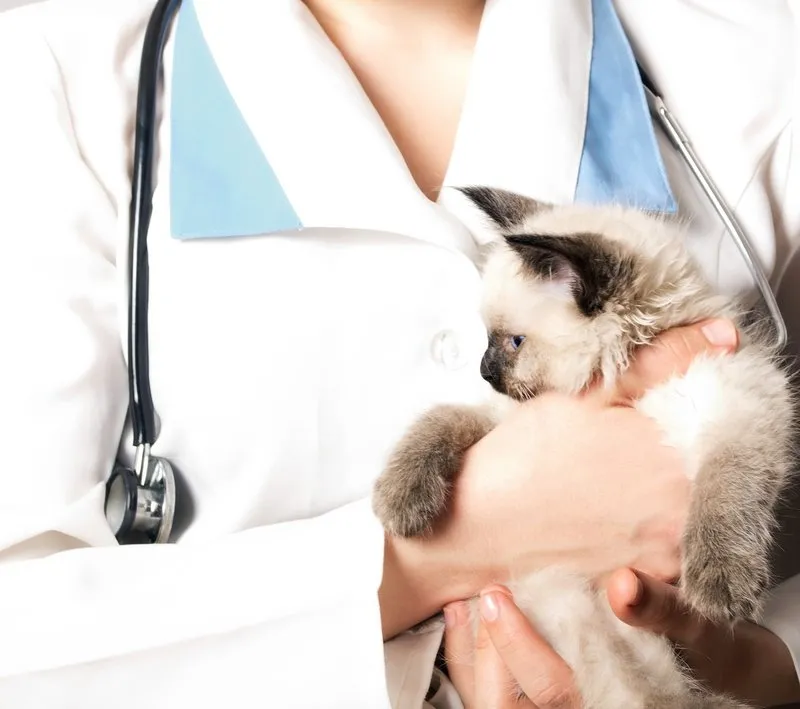Cats make wonderful pets. Not only are they wonderful companions and fun to have around, cats are actually good for your health; Studies have shown that stroking a cat can lower your blood pressure. However, feline veterinary health visits have been declining in the USA and Canada. On average, cats visit the veterinarian less than half as often as dogs.
One reason for this decline, in addition to the upset of the visit itself, stems from many cat owners ascribing to the myth that indoor kitties do not get sick. It is true that indoor cats are less at risk for trauma and infectious disease but they are at equal risk for bladder problems, kidney disease, dental disease, tummy upsets and in fact, are more likely to suffer from obesity and diabetes mellitus due to lack of exercise. Many cats are brought to the vet as kittens but then not examined again until they are in their teens suffering from a potentially life-threatening disease. Unfortunately, cats tend to hide when they are unwell and unless you are carefully looking for subtle signs or changes in their behaviour, the problem is well-advanced by the time it is noticed. Regular physical examinations by a veterinarian are essential to maintain an excellent quality of life for your beloved pet.
“Fraidy Cats”
We realize that cats can be very nervous coming to the clinic. Many cats have not been acclimated to their carriers, and are nervous of cars. Then they have to face the clinic which has strange odours and unfamiliar sounds and maybe even dogs! It can be panic inducing and cats that are very loving at home can suddenly become very fearful and agitated, striking out in defence. Not only is this scary for the kitty, it is very upsetting for you and for the veterinary team.
The doctors and staff at Markham Veterinary Clinic wish to see more cats get the healthcare they need and deserve. To help reduce their anxiety with the visit, we have established blocks of appointment time in which only cats will be examined in the clinic. No dogs will be in the reception area at the same time. As many kitties don’t like other cats as well, you will be welcomed into an exam room immediately to give your pet time to get used to the room. (A cat generally needs 5 to 10 minutes in a room to get acclimatized to a new environment.) A synthetic pheromone, mimicking a natural pheromone deposited when your cat rubs its face on objects, will already be in the room to assist in calming your kitty. We will also try to do all of the examination and sample collection in the same room to reduce any anxiety of being moved to a new room. For the real “fraidy” cats, medication can be dispensed to your pet before your arrival to reduce panic. (This medication is NOT a sedative!)
We believe cats are safer when transported in a carrier and we are encouraging more people to teach their cat to like the carrier. Make your cat carrier a friend, not a foe!! See below for a video showing a successful technique to accomplish this goal. If you need any more assistance, please speak to any of our team who will be more than happy to give you any extra information.
If you find the trip to the clinic stressful, check out the video below for helpful tips on how to make the trip a breeze.
Helpful Tips
Please try some or all of the suggestions for your cats next visit to the vet:
- Place treats in the carrier to make it a happy place.
- Spritz the inside of the carrier with a cat-calming pheromone product (a synthetic copy of a cat’s “friendly” facial scents) at least 10 minutes prior to the trip.
- A big meal just before a car ride could cause an upset tummy for cats that get car sick. At the same time, taking food away for too long before a veterinary visit can create stress. Ask your veterinarian what’s best for your cat.
- If your cat has a favourite toy, bring it along. Also, bring a towel or blanket that has the scent of family members, as well as your cat’s smell. We will use the “blanky” on our exam table and put your cat on it. Some cats also prefer the security of a second towel draped over the carrier during transport.
- Your lap is a good place for a carrier (the cat sees and smells you and is off the ground). You will be moved in a quiet exam room as soon as possible.
- Try to chitchat a few minutes with your veterinarian before the exam begins, perhaps relaying any changes in your cat’s recent behaviour. As you do so, your cat can become acclimated to the new surroundings.
- Talk softly; sometimes voices in exam rooms echo or you may speak louder than normal. On the other hand, avoid whispering which can sound like “hissing” to a cat.
What to Look For
It is less expensive to prevent disease than to treat it emphasizing the value of regular veterinary visits. However, if you spot any of the following signs, a veterinary visit is definitely needed.
- Changes in interaction: For example, a previously clingy cat that is hiding or acting aloof or a more independent cat that suddenly transforms into “Velcro Kitty”
- Changes in activity: Any change in your cat’s daily routine can be a sign of a medical concern. You may see this as a decrease or increase in activity. An example of this change would be a cat who normally jumps up onto furniture or onto a cat tree, but now hesitates or walks away. No longer jumping may indicate discomfort; arthritis is far more common in elderly kitties than previously thought.
- Changes in chewing or eating habits: Contrary to popular belief, most cats are not finicky eaters. Look for changes such a decrease or increase in how much the cat eats. Eating less can be a sign of several disorders, ranging from dental problems to cancer. Increased eating can be caused by diabetes, hyperthyroidism or other health problems.
- Changes in water intake: Drinking more or less water can be an indicator of a health problem, such as diabetes or kidney disease.
- Unexpected weight loss or weight gain: Weight doesn’t always go up or down with a change in appetite. Cats with diabetes or hyperthyroidism, for example, may lose weight even if they eat more.
- Bad breath: If those pearly whites don’t smell sweet as a daisy, there may be a dental and/or gum issue. Bad breath may also be related to a digestive disorder, infection or kidney disease.
- Changes in grooming habits: Fastidious groomers letting themselves go — even just a little bit – might be ill. Over-grooming may be related to stress, pain or skin conditions.
- Changes in sleeping habits: Watch for an increase in “catnapping” or being awake more often in the middle of the night. The explanation for these changes may be illness.
- Changes in vocalization: Quiet cats that begin to vocalize or cats that howl in the night may be doing so as a result of a medical problem. Feline cognitive dysfunction (feline Alzheimer’s), hyperthyroidism, high blood pressure or anxiety are among the possible explanations.
- Signs of stress: Cats dislike change more than anything. Changes in your family’s routines and schedule, also new pets in the home, or even as simple as rearranging the furniture can cause stress. Geriatric cats may be particularly sensitive to these changes. Anxious cats may act out their stress with inappropriate behaviour (ie missing the litter box or fighting with another cat in the house). Anxiety requires the same professional attention as diabetes or a heart condition.
- Urinating out of the box even if only one time! It is known that urinating out of the box may be caused by medical or behavioural problems(or sometimes both). However, it is also known that the longer the behavior continues the more difficult it is to correct it.
- Taken from “CATegorical Care: An Owner’s Guide to America’s “1 Companion
– Written by Steve Dale CABC, coauthored by Amy Shojai, CABC and Beth Adelman, CABC
In addition, because illness is so commonly associated with changes in a cat’s activities of daily living, it’s a good idea to create a “healthy profile” for your cat. That way, you and your veterinarian will know what is normal for your cat so that in the future, it will be much easier to notice when something out of the ordinary happens. Most importantly, trust your instincts! If your kitty seems “off” or different in anyway, it is time for a visit to the veterinarian.
At Markham Veterinary Clinic, we recommend annual examinations for cats and for senior cats every 6 months.
Markham Veterinary Clinic
6605 Hwy#7 East, Unit 13/14
Markham, ON L3P 7P1
t: (905) 294-0522
f: (905) 294-0932
Also serving Unionville, ON and surrounding areas.
Working Hours
Monday – Thursday: 8:30am to 7pm
Friday: 8:30am to 6pm
Saturday: 8:30am to 12pm







!Social Media Icons